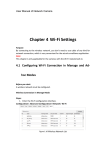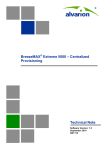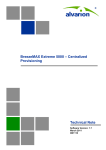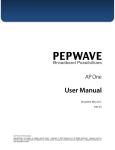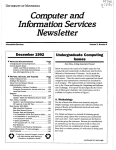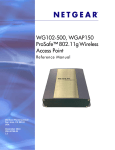Download MultiAP 700G User Manual
Transcript
MultiAP 700G User Manual Aug-12 COPYRIGHT & TRADEMARKS Specifications are subject to change without notice. Copyright © 2012 ValuePoint Networks. All Rights Reserved. ValuePoint and the VP logo are trademarks of ValuePoint Networks. Other brands or products mentioned may be trademarks or registered trademarks of their respective owners. Table of Contents 1 INTRODUCTION AND SCOPE .................................................................................... 3 2 PRODUCT FEATURES ................................................................................................ 3 3 INSTALLATION............................................................................................................. 4 5.1 5.2 INSTALLATION PROCEDURES .................................................................................................. 4 QUICK START ........................................................................................................................ 6 4 INFORMATION.............................................................................................................. 6 6.1 6.2 6.3 6.4 6.5 SYSTEM ................................................................................................................................ 6 W IRELESS ............................................................................................................................. 7 WDS.................................................................................................................................... 8 EVENT LOG ........................................................................................................................... 8 NEIGHBOR APS ..................................................................................................................... 9 5 CONFIGURATION ...................................................................................................... 10 7.1 7.2 7.3 7.4 7.5 7.6 SYSTEM SETTINGS .............................................................................................................. 10 W IRELESS NETWORKS SETTINGS ......................................................................................... 16 ADVANCED SETTINGS .......................................................................................................... 26 WDS SETTINGS .................................................................................................................. 30 SNMP SETTINGS ................................................................................................................ 32 W EB ADMIN SETTINGS......................................................................................................... 35 6 DIAGNOSTIC TOOLS................................................................................................. 37 7 COMMANDS................................................................................................................ 38 8 PER USER VLAN TAGGING ..................................................................................... 40 APPENDIX A..................................................................................................................... 41 APPENDIX B..................................................................................................................... 42 1 Introduction and Scope MultiAP 700G is a carrier-grade 802.11b/g Wi-Fi access point with centralized management system. It is a powerful solution for building wireless networks for Wireless Internet service, wholesalers and enterprises. Each MultiAP 700G is loaded with essential features such as Multiple SSID (virtual AP with distinct ESSID and BSSID), VLAN, and a high-gain antenna. One MultiAP 700G can masquerade up to 16 different access points. Each virtual access point can have its own security policy (e.g. WPA, WPA2, etc.) and authentication mechanism (e.g. 802.1x, open, captive portal, etc), to facilitate building your wholesale network much faster, easier and more cost-effective than ever before. MultiAP 700G comes with a high-power Wi-Fi transmitter which greatly enhances coverage and performance. 2 Product Features Key features of MultiAP 700G: Designed for wholesale wireless networks with multiple SSID and VLAN support Independent security policies and encryption mechanisms per virtual AP Centralized managed via web based MultiAP Central Management System (PCMS) High-power output enhances coverage and lowers cost of ownership WMM (Wi-Fi Multimedia) and QoS (Quality of Service) Support WDS (Wireless Distribution System) Support Captive Portal Support Mesh Connector Bridging 3 Installation MultiAP 700G acts as a bridge between the wireless and the wired Ethernet interface. A typical setup is as follows: 3.1 1. 2. 3. 4. 5. 6. 7. 8. Installation Procedures Attach the antenna to the MultiAP 700G unit. Connect the LAN port on the unit with the backbone network using an Ethernet cable. The port could auto sense the cable is straight-through or cross-over. Connect the power adapter to the power connector of the unit, and then plug in the power adapter. Wait for the status LED to turn green. Connect a PC to the backbone network, and configure the IP address of the PC to be any IP address between 192.168.0.4 and 192.168.0.254, with subnet mask of 255.255.255.0. With Microsoft Internet Explorer 6 or above, or Mozilla Firefox 2.0 or above, connect to the URL https://192.168.0.3. When prompted, enter the default admin login ID and password: admin and public respectively. This default username and password can be changed in the web admin. Please refer to section 5.6.2 for details. After logging in, the following Main Menu page appears to facilitate further configuration of the MultiAP 700G unit: 3.2 Quick Start By default, an access point is preset with SSID: wireless The default access point bridges the Wi-Fi interface to the Ethernet port, with both encryption and VLAN tagging disabled. To access the backbone network connected via the Ethernet port of the unit, establish a session at the Wi-Fi interface with a Wi-Fi client. After establishing a Wi-Fi client session, information about the established Wi-Fi session appears at the Web Administration Interface of MultiAP 700G, under the section at Information-> Wireless. 4 Information 4.1 System System Information AP Name This field shows the name of the system entered in the configuration. Location This field shows the location entered in the configuration. Domain Name Network IP Mode Network IP Address Network Subnet Mask Network Gateway Network DNS Software Versions Serial Number Up Time System Time Time Zone Mac Address This shows the domain name used for this system. This shows the current IP used on the system. This shows the current subnet mask used on the system. Comment: This shows the detected/assigned network gateway of the device. Comment: This shows the detected/assigned network DNS of the device. This shows the current firmware version running on the system. This shows the serial number of the device. This shows the time has been up since boots up. This shows the time of day in respect to the time zone selected. This shows the time zone the system is using. This shows the LAN MAC address of this system. L2TP Tunnel Status Tunnel IP Address Comment: This field can be set in Configure > System. The three options available are: DHCP, Static IP and PPPoE (Router Mode only). This shows the status of the L2TP service. This shows the IP acquired in the established tunnel. Tunnel Netmask This shows the subnet mask acquired in the established tunnel. Firmware / Flash Firmware Version Flash Status Boot from Firmware Upgrade Target 4.2 This shows the firmware version loaded into the flash partitions. This shows the firmware status on the flash partitions. This indicates which flash partition boots up the system. This shows which flash partition is used for firmware upgrade. Wireless Wireless Information Name Number of WLANs Current Clients Current Channel Current Status This shows the system name defined in previous section. This shows number of added SSIDs. This indicates the number of associated clients. This shows which 802.11 channel the system is using. This shows the current status of the device. Connected Clients Manufacturer This shows the manufacturer based on the MAC prefix. MAC address This shows the client MAC address. WLAN SSID VID Type Authentication This shows which SSID the client is associated. This shows the VLAN ID used on the SSID. This shows the radio mode of the client. This shows the client authentication. Status This shows the association status and the associated duration. Details This links to the detailed page of each client. For information about the Clients Details, please refer to section 5.2. Comment: ? any other than On? 4.3 WDS Auto WDS Status Bssid This shows the wireless MAC address of the device. Parent This shows the parent node of the device. Channel This shows the channel of the existing Bssid. Level This shows the hop level of the device. State This shows the state of the node: wired or wireless. Neighbor WDS APs Bssid This shows the wireless MAC address of the Neighbor WDS node. Parent This shows the parent node of the Neighbor WDS node. Channel 4.4 This shows the channel of the existing Bssid. RSSI This shows the signal strength of the node. Level This shows the hop level of the node. State This shows the state of the node: wired or wireless. Event Log Upon selecting Event Log from the navigation bar on the left-hand-side of the Main Menu, the system log is displayed. The system log is intended to provide information to aid troubleshooting in the event of operational issues. Comment: 4.5 Neighbor APs Neighbor APs Neighbor AP Discovery Scanning Interval Scanning Time This shows the feature Neighbor AP Discovery is enabled. To disable or configure the Scanning Interval and Scanning Time options, please refer to section 5.3.2. This shows the scanning interval for Neighbor AP Discovery. This shows the scanning time for Neighbor AP Discovery. Neighbor APs Manufacturer This shows the manufacturer based on the MAC prefix. SSID This shows the ESSID of the scanned access point. Ch This shows the channel of the scanned access point. RSSI Security This shows the signal strength of the access point. This shows the encryption type of the access point used. BSSID This shows the wireless MAC address of the access point. Last Seen This indicates the time stamp of the access point scanned. Status This shows whether the access point can be detected or not. 5 Configuration 5.1 System Settings General Access Point Settings AP Name A user-specified name for the access point. This value can be retrieved via SNMP. Location A user-specified name for the location of the access point. This value can be retrieved via SNMP. AP Mode This option enables the access point running as a bridge or a router. When the access point runs as a router, the Management VLAN ID is ignored and the LAN settings appear for proper network setup. Domain Name Domain name can be set for wireless clients to have a readable name for both web management and captive portal redirection URLs. Server IP This specifies the unique IP address for the MultiAP 700G unit to communicate on the Ethernet segment. This IP address is distinct from the admin IP address 192.168.0.3 on the Ethernet segment. If Keep Default IP is set, the default IP would be available on the system along with the Server IP setting. If DHCP is set, the IP address of the MultiAP 700G unit is then acquired from a DHCP server on the Ethernet segment. If Static IP is set, it is required to enter the information related to that static IP, including Static IP address, Subnet Mask, Default Gateway and DNS Server. If PPPoE is set, it is required to enter the information related to that PPPoE connection: PPPoE Username, PPPoE Password, PPPoE Service Name. This option is only available with Router mode. Management VLAN ID This specifies the VLAN from which management sessions are allowed. The establishment of management sessions is restricted only to the specified VLAN ID. If Management VLAN ID is set to zero, no VLAN restriction is applied. The default value of this setting is zero. It means no tagging is enabled (instead of tagged with zero). This option is only available in Router mode. Timezone This option specifies the time region to be used for representing the time on the system. NTP Server This is the Network Time Protocol (NTP) Server hostname to be used for synchronizing system clock of MultiAP 700G. The default value of this setting is pool.ntp.org. STP Spanning Tree Protocol, STP can be enabled to prevent path redundancy. With this enabled, two more options are provided: Bridge Priority and Ethernet Path Cost. Bridge Priority (If STP is enabled,) the parameter is set to give the likeliness for root switch election. Ethernet Path Cost 5.1.1 (If STP is enabled,) this gives the preference to provide the best path from the switch to the root switch. LAN Settings LAN Settings will only be available when the AP Mode in the previous section had been selected as Router mode. You can use the 700G as a DHCP server for other devices behind. 5.1.2 L2TP Tunnel Settings L2TP Tunnel Settings L2TP Tunnel Enabling L2TP option on the system would start the tunnel establishment from the access point to the server for centralized traffic management. L2TP Server Address This specifies the L2TP server IP address for the access point to connect to. L2TP/PPP Username This specifies the L2TP/PPP Username for tunnel authentication purpose. L2TP/PPP Password This specifies the L2TP/PPP Password for tunnel authentication purpose. Tunnel IP Address This specifies the unique IP address for the MultiAP 700G unit to communicate over the tunnel. If From DHCP is set, the IP address of the MultiAP 700G unit is then acquired from a DHCP server over the tunnel. Tunnel IP Address and Tunnel Subnet Mask will be disabled automatically. Tunnel Subnet Mask This setting specifies the subnet mask of the MultiAP 700G unit over the tunnel. Tunnel Management VLAN This specifies the VLAN from which management sessions are allowed over the tunnel. The establishment of management sessions is restricted only to the specified VLAN ID. If Management VLAN ID is set to zero, no VLAN restriction is applied. The default value of this setting is zero. It means no tagging is enabled (instead of tagged with zero). 5.1.3 Security Settings Security Settings Layer 2 Communication Layer 2 is in reference to the second layer in the ISO Open System Interconnect model. When this option is disabled, clients on the same VLAN, SSID or subnet are not allowed to communicate directly via the Layer 2 Protocol(s). Traffic is passed to upper communication layer(s). With this option enabled, clients on the same VLAN are allowed to communicate with each other directly. (Windows network resources browsing will be possible.) By default, the setting is enabled. 802.1X Version This setting selects between v1 or v2 of the 802.1x EAPOL. When v1 is selected, both v1 and v2 clients can associate with the access point. However, when v2 is selected, only v2 clients can associate with the access point. Most modern wireless clients support v2. In the event that there are stations that do not support v2, select the option v1. By default, the value of the setting is v2. Management from Wireless Clients With this option enabled, Web Admin is accessible from the Wi-Fi segment of MultiAP 700G. By default, it is enabled. Syslog to Remote Server With this option enabled, logs are sent to an external Syslog server. By default, this option is disabled. Syslog Server Address / Port When the Syslog to Remote Server is enabled, this option is enabled for entering the Syslog server IP address and port number. By default, the port number is 514. 5.1.4 Radius Server Settings Radius Server Settings Primary Authentication Server Secondary Authentication Server Secret When 802.1x authentication is configured, the Radius server specified by this setting will be used for authentication. This setting specifies the Radius server to be used for authentication in the event that the host specified by Primary Host is unavailable. This is the secret for accessing the Radius server. Authentication Port This specifies the UDP port number for the Authentication port of the Radius server. Primary Accounting Server When 802.1x authentication is configured, the Radius server specified by this setting will be used for accounting. Secondary Accounting Server Secret Accounting Port Re-authentication Time Maximum Retransmission Radius Request Interval This setting specifies the Radius server to used for accounting in the event that the host specified by Primary Host is unavailable. This is the secret for accessing the Radius server. This specifies the UDP port number for the Accounting port of the Radius server. This is the re-authentication time interval. Enter 0 to disable reauthentication. By default, it is set as 0 (disable). This specifies the maximum number of retry for RADIUS authentication. By default, it is set as 3. This specifies the time interval in second between each RADISU request attempt. Note that the request time interval would be doubled every retransmission. By default, it is set as 3s. 5.1.5 802.11b/g Profile 802.11 b/g Profile Three options are available: Radio Policy • 802.11b/g (Mixed Mode): MultiAP 700G accepts both 802.11b and 802.11g client association requests. • 802.11b Only: MultiAP 700G accepts only 802.11b client association requests. • 802.11g Only: MultiAP 700G accepts only 802.11g client association requests. Country This setting specifies the country / region whose regulations the MultiAP 700G unit should follow. Users are required to choose their operating country based on their actual location. Laws, restrictions and regulations of use of electronic goods apply to different countries. Available RF channels and Maximum transmission power options rely on the selected operating country. By default, United States is selected. RF Channel This option selects the 802.11 channel to be utilized. Available options for 802.11b and 802.11g are from 1 to 11 and from 1 to 13 respectively, depend on the operating country selected in the previous option. Tx Output Power This option selects the transmit output power of the 700G device. Available options are from 26 dBm to 17 dBm and 20 dBm to 11 dBm, depend on the operating country selected in the previous option. By default, Tx Output Power is configured to be 26 dBm. Antenna Selection For MultiAP 700G Outdoor units, the hardware may be equipped with two antennas for transmit and receive diversity. If the MultiAP 700G unit is equipped with two antennas, users can select Main, Auxiliary and Both (Diversity) with antenna diversity. By default, Main antenna is selected. Comment: New feature 5.2 Wireless Networks Settings Upon selecting Wireless Networks under Configure section from the navigation bar on the left, the following shows the configured SSID available on the system: General Wireless Networks Settings Wireless Network SSID Default VLAN ID Admin Status Security Policies BSSID The SSID of the virtual Access Point (AP). This setting specifies the VLAN ID to be tagged on all outgoing packets generated from the virtual AP (i.e. packets that travel from the Wi-Fi segment, through the MultiAP 700G unit to Ethernet segment via the LAN port). If 802.1x is enabled, a per-user VLAN ID can be specified in the authentication reply from the Radius server. If it is set, the value specified via Default VLAN ID will be overridden. This option shows whether the virtual AP is enabled or disabled. This option shows the configured wireless authentication and encryption methods. This field shows the detailed BSSID. Wireless Networks Details Enable Select Yes to enable the virtual AP, or No to disable the virtual AP. By default, the virtual AP is enabled. Wireless Network SSID This setting specifies the SSID of the virtual AP to be scanned by Wi-Fi clients. The value is not case sensitive. By default, the value is MultiAP_XXXX, where the substring XXXX in the SSID is replaced by the last four hex digits of the LAN MAC address of the unit. Default VLAN ID This setting specifies the VLAN ID to be tagged on all outgoing packets generated from the virtual AP (i.e. packets that travel from the Wi-Fi segment, through the MultiAP 700G unit to Ethernet segment via the LAN port). If 802.1x is enabled and a per-user VLAN ID is specified in the authentication reply from the Radius server, then the value specified via Default VLAN ID will be overridden. The default value of this setting is 0. That means VLAN tagging is disabled (instead of tagged with zero). Broadcast SSID This setting specifies whether or not the ESSID of the virtual AP can be scanned by Wi-Fi clients. Note that the BSSID (i.e. the MAC address of the virtual AP) cannot be hidden from the scan. To associate with the virtual AP, clients must specify the correct ESSID upon association. Broadcast SSID is enabled by default. Multicast Filter This setting enables the filtering of multicast network traffic to the wireless SSID. By default, it is set as enabled. Multicast Rate This setting specifies the transmit rate to used for sending multicast network traffic. Data Rate There are two options on data rate: Fixed, Auto Fixed will forced all data packets to be transmitted into the selected transmit rate. Auto will automatically select the best transmit rate with a condition to use the selected transmit rate as the minimum auto transmit rate. Default Quality of Service The 802.1p QoS value to be marked on all outgoing packets generated from the virtual AP (i.e. packets that travel from the Wi-Fi segment, through the MultiAP 700G unit to Ethernet segment via the LAN port). If per-user or per-domain QoS value is specified, the Default Quality of Service value will be overridden. Possible values are Gold, Silver and Bronze. This setting selects among the following options: • • DHCP Server Type • None: DHCP requests will be passed to the Ethernet segment, and will not be processed by MultiAP 700G. Relay: MultiAP 700G will forward DHCP requests to a specified DHCP Server. This option prevents broadcast messages from being propagated on the Ethernet segment. Upon selecting this option, the DHCP Server IP address will be prompted. Server: MultiAP 700G will allocate and offer IP addresses locally. For further details, please refer to Section • • DHCP Server • Please refer to the following sections, 5.2.1 and 0 for details. Security Policy This setting configures the wireless authentication and encryption methods. Available options are: None, Static WEP, 802.1x and WPA. Selecting None disables encryption. For details on the other options, please refer to the following sections: • • • Maximum Associated Clients Access Control 5.2.3 - Static WEP Parameters 0 - 802.1x Parameters 5.2.5 - WPA Parameters This setting limits the number of associations allowed to the SSID. The default value zero would be treated as unlimited. The settings allow administrator to control the access through Mac address filtering. Available options are: None, Deny all except listed, Accept all except listed. For details on the other options, please refer to Section 5.2.6 - Access Control. Alternative Radius Server Setting Captive Portal Bandwidth Management The settings provide an alternative Radius setting for the SSID. With this enabled, the settings would overwrite the Radius settings under system in section Configure. For details on the other options, please refer to Section 5.1.4 Radius Settings. This setting enables the captive portal capability on the access point to do URL redirection with different authentication. For details on the other options, please refer to Section 5.2.7 Captive Portal Settings. This option enables the settings to control upstream and downstream limits. For details please refer to Section 5.2.8 – Bandwidth Management. Alternative Layer 2 Communication Setting With this option enabled, 3 more options for Layer 2 Communication settings will be available. For details, please refer to Section 5.2.9 – Alternative Layer 2 Communication Settings. Wireless Network Filter This option enables the access point to filter network traffic based on the users’ defined rules. Users can use MAC address, IP address and protocol to form the matching rules to perform either drop or accept policy. For details please refer to Section 5.2.10 – Wireless Network Filters. WMM Mesh Connector Bridging 5.2.1 This option enables the Wi-Fi Multimedia (WMM), as known as Wireless Multimedia Extensions (WME) on the access point. This option enables the transparent bridging functionality with MultiAP Mesh Connector to achieve true layer two transparency. This option should be checked if users want to bridge traffic from a 700G to Mesh Connector. DHCP Server For the setting DHCP Server Type, if the value Server is selected, DHCP Server Parameters are entered via the following screen up selection: Comment: DHCP Server Parameters IP Start Range This setting specifies the first address in the range of IP addresses to be assigned to DHCP clients. IP Stop Range This setting specifies the last address in the range of IP addresses to be assigned to DHCP clients. Subnet Mask Broadcast Address This setting specifies the broadcast address to be used by DHCP clients. Gateway This setting specifies the default routing gateway to be used by DHCP clients. DNS 1 This setting specifies the IP address of the primary DNS Server to be offered to DHCP clients. DNS 2 This setting specifies the IP address of the secondary DNS Server to be offered to DHCP clients. DNS 3 This setting specifies the IP address of the tertiary DNS Server to be offered to DHCP clients. Domain Lease Time 5.2.2 This setting specifies the subnet mask to be used by DHCP clients. This setting specifies the domain name of the Wi-Fi segment. This setting specifies the length of time throughout which an IP address of a DHCP client remains valid. Upon expiration of the Lease Time, the assigned IP address will no longer be valid and the renewal of the IP address assignment will be required. DHCP Relay For the setting DHCP Server Type, if the value Relay is selected, DHCP relay parameters will be available via the following screen up selection: DHCP Relay Parameters DHCP Server IP This setting specifies the IP address of the DHCP server. Comment: 5.2.3 Static WEP The configuration of Static WEP parameters enables pre-shared WEP key encryption. Authentication is not supported by this method. The security level of this method is known to be weak. Static WEP parameters are entered via the following screen upon selection: Static WEP Parameters Key Size The setting can be configured as either 40 bits (64-bit WEP), 104 bits (128bit WEP) or 128 bits (152 bit WEP). Key Format The setting can be configured as either ASCII or HEX. Passphrase Combination of words and characters used to generate an encryption key. Click Generate Key to create the key. Encryption Key This setting specifies a user-specified encryption key value. For ASCII format, key length is either 5 or 13. For HEX format, key length is either 10 or 26. Shared Key Authentication This setting enables the use of shared key authentication. Open authentication is the default authentication. 5.2.4 Comment: 802.1x Parameters The configuration of 802.1x parameters enables Radius-based 802.1x authentication with a dynamic WEP key. The configuration screen is as follows: 802.1x Parameters Dynamic Key Encryption Key Size Re-keying Period Check the box to enable the Dynamic Key Encryption. Key Size and Rekeying Period will be enabled automatically. The setting can be configured as either 40 bits or 104 bits. This setting specifies the length of time throughout which the broadcast key remains valid. Upon expiration of Re-keying Period, the broadcast key will no longer be valid and the renewal of the broadcast key will be required. Comment: Comment: The default value 0 means to disable re-keying. 5.2.5 WPA parameters The configuration of WPA parameters enables WPA-TKIP or WPA2-AES. To enable WPA and WPA-PSK, configure WPA-TKIP. To enable WPA2 and WPA2-PSK, configure WPA2-AES. When WPA or WPA2 is configured, Radius-based 802.1x authentication with TKIP encryption method is enabled. Under this configuration, the Pre-Shared Key option should be disabled. The security level of this method is known to be very high. When WPA-PSK or WPA2-PSK is configured, a Pre-Shared Key, or Pass Phrase, is used for data encryption and authentication. Under this configuration, the Pre-Shared Key option should be enabled. Key length must be between 8 and 63 characters (inclusive). The security level of this method is known to be high. 5.2.6 Access Control The settings allow administrator to control the access through Mac address filtering. Available options are: None, Deny all except listed and Accept all except listed. Enter or Choose MAC address(es) in the box of MAC Insertion Tool on the right, and then click <<<Add to list. MAC address(es) will be added into the filter. To delete a selected MAC address in the list, click and highlight a MAC address in the box on the left, then click Delete highlighted. 5.2.7 Captive Portal Settings User can build and develop their own Captive Portal using PHP and then redirect all clients to the assigned server for authentication. Captive Portal Settings Redirect URL Authentication URL This setting specifies the URL to be used to redirect the users. HTTP and HTTPS are available for the choice of protocols. This setting will only be available if you have chosen Plain Key Authentication or Shared Key Authentication as the authentication method. It specifies the authentication URL to be used. HTTP and HTTPS are available for the choice of protocols. Comment: Comment: Access Timeout This setting specifies the allowed access time. When the timeout reaches, users would be redirected to the “Redirect URL”. Inactive Timeout This option sets the value of timeout when user stays inactive. Pass-through IPs This setting specifies the IPs that users can go to without redirection control. Authorized MAC Addresses This setting specifies the list of MAC addresses in which the authentication and redirection are bypassed. The option is particularly useful when devices do not have browser capability, such as wireless VoIP phone. Authentication Method This setting specifies the method to do user authentication and the options are: No Authentication, Plain Key Authentication, Shared Key Authentication, and RADIUS Authentication. Authentication Key This setting specifies the authentication key which is only available when Plain Key Authentication or Shared Key Authentication has been selected. 5.2.8 Comment: new Bandwidth Management Bandwidth Management Per VAP Settings / Per Client Settings Upstream Limit Downstream Limit 5.2.9 Upstream Limit and Downstream Limit can be set for each VAP or each Client. This option set the upstream bandwidth limit. The default value 0 means Unlimited. This option set the downstream bandwidth limit. The default value 0 means Unlimited. Alternative Layer 2 Communication Setting Comment: new Alternative Layer 2 Communication Setting Separate Unicast packets Separate Broadcast / Multicast packets Separate between SSIDs Check the box to enable the separate unicast packet feature for Layer 2 communication. Check the box to enable the separate broadcast / multicast packets feature for Layer 2 communication. Check the box to enable the separate between SSIDs feature for Layer 2 communication. Comment: new 5.2.10 Wireless Network Filters Wireless Network Filters Name This setting defines the name of the filter. Source / Destination MAC Address This setting specifies the source / destination MAC address(es) to be filtered. Source / Destination IP Address / Netmask This setting specifies the source / destination IP address(es) and the Netmask to be filtered. Source / Destination Port This setting specifies the source / destination Port(s) to be filtered. Protocol This setting specifies the Protocol to be filtered. Policy This option defines the policy of this filter. Available options are accept and drop. Enable Check the box to enable or disable this filter. You can delete any existing filter by clicking the Remove bottom on the right of the Filter List. 5.3 Advanced Settings Advanced Settings provides more options to fine tune the parameters on the system to achieve the optimal performance. 5.3.1 Wireless Settings Wireless Settings Max. Total Associated Clients This value defines the maximum number of clients in total can be associated with the device. The default number 0 means unlimited. Beacon Rate This setting provides the option to send beacon in different transmit bit rate and the bit rates are: 1Mbps, 2Mbps, 5.5Mbps, 6Mbps, 11Mbps. Beacon Interval This setting provides the option to set the time between each beacon send. Available options are: 100ms, 250ms, 500ms. DTIM This setting provides the option to set the frequency for beacon to include Delivery Traffic Indication Message, DTIM. The interval unit is in millisecond. RTS Threshold This setting provides the option to set the minimum packet size for the unit to send an RTS using the RTS/CTS handshake. Setting zero would disable this feature. Fragmentation Length This settings provides the option to set the fragmentation length. Distance / Time Convertor This is a convertor to automatically adjust the Slot Time, ACK Timeout and CTS Timeout by entering the distance between the device and the clients. Slot Time This setting provides the option to modify the unit wait time before it transmits. Comment: Comment: ??? Comment: ACK Timeout This setting provides the option to set the wait time to receive acknowledgement packet before doing retransmission. CTS Timeout This setting provides the option to specify the timeout for the unit to wait for CTS response in the RTS/CTS handshake. 802.11g Protection When this option is enabled, 802.11g devices would be in favor in mixed mode (11g and 11b) networks. Preamble Type Preamble Type defines the length of the CRC block for communication between the AP device and adapters. Available options are Long and Auto. A long preamble type can be selected if the device is operating in a ‘noisy’ network environment. By default, it is set as Auto. 5.3.2 Neighbor AP Discovery Neighbor AP Discovery Neighbor AP Discovery Scanning Interval Scanning Time 5.3.3 Check the box to enable the function of scanning neighbor APs. This setting determines how often the access point goes to other channels to discover Neighbor AP. This setting determines how long the access point stays on the other channels to discover Neighbor AP. Ethernet Settings Ethernet Settings Speed This setting provides the option to set the speed of the Ethernet. Comment: 5.3.4 Health Check Comment: new Health Check Method Ping Host 5.3.5 Select Ping to enable the health check function. Enter the IP address of Ping host. By default, the box Use default gateway as Ping Host is checked and enabled. Interval This value defines the interval of health check pings. Retries The number of retry when the health check is failed. Scheduled Tasks Scheduled Tasks Self Maintenance The system would perform reboot based on the scheduled time selected. Auto Channel Selection The system would perform auto channel selection to avoid congested channel when no clients currently associated to the access point. Radio On/Off Period This option specify the time period which radio would be switched ON or OFF. If there are no entries, radio will be set as ON automatically. Note Comment: the whole section has been updated Schedule tasks will be started after date synchronized from NTP server. 5.4 WDS Settings Wireless distributed system, WDS provides a way to link APs together when wired cabling is not preferable. This also extends the wireless coverage of the wireless network for the wireless clients. There are two options available: Auto and Manual. 5.4.1 Auto WDS Mode Auto WDS Mode There are three options: Auto Detect, Wired, and Wireless • Auto Detect - the unit would check the connectivity to the default gateway via wired Ethernet to determine the node type. If there is connectivity to the default gateway, the unit would state its node type as gateway. Otherwise, the unit would state its node type as node. • Wired- the unit is expected to be wire-connected to provide public network access to other wireless nodes. • Wireless - the unit would search for the best gateway or node wirelessly in order to gain public network access. Node Type AES passphrase This setting gives the encryption passphrase for AES encryption to secure the date between APs. 700G devices will match this AES passphrase with each other and for those matched will be connected for Internet connection. Comment: 5.4.2 Manual WDS Mode By clicking the ADD button under Manual WDS Settings, you can configure WDS connections manually. Manual WDS Mode Enable MAC Address Security Policy This option enables this entry. This setting gives the MAC address of the other AP to form a WDS link. For more detail, please refer to section 5.2.3 Static WEP. Comment: 5.5 SNMP Settings Upon selecting SNMP Server Settings from the navigation bar on the left-hand-side of the Main Menu, the following page is displayed to enable the configuration of SNMP server settings: SNMP Settings Server Name This setting specifies the name that identifies the SNMP server. SNMPv1 This setting specifies whether to enable or disable the support for Version 1 of SNMP. SNMPv2 This setting specifies whether to enable or disable the support for Version 2 of SNMP. SNMPv3 This setting specifies whether to enable or disable the support for Version 3 of SNMP. SNMP Trap SNMP Trap is a message initiated from a client and sent to the 700G device. Once this option is enabled, the following two options for SNMP Trap will be available for configuration. SNMP Trap Receiver Name SNMP Trap IP Address (When SNMP Trap is enabled) This setting specifies the SNMP Trap Receiver Name. (When SNMP Trap is enabled) This setting specifies the SNMP Trap IP Address. By clicking the New button next to SNMPv1/v2 Communities or SNMPv3 Users, you can add new communities and users accordingly. 5.5.1 SNMPv1 / SNMPv2 Communities By adding SNMPv1/v2 Communities, access rights can be controlled. SNMPv1 / SNMPv2 Communities Community Name The “password” for getting or setting SNMP values. IP Address and IP Mask The allowed subnet address who can access the SNMP server Access Mode Status Choose the access mode for this community name to either Read Only or Read & Write. Select to Enable or Disable this community. 5.5.2 SNMPv3 Users By adding SNMPv3 users, access rights can be controlled. SNMPv3 User Setting SNMPv3 User Name The user ID to be allowed to access the SNMP agent. Authentication Protocol The protocol for authenticating the user. Available options are: HMAC-MD5 and HMAC-SHA. Authentication Password Only users provided with a correct password will be granted the right to access the SNMP agent. Privacy Protocol Privacy Password Access Mode Status The encryption method to be used in SNMPv3 communication. Available options are: None and CBC-DES. (When CBC-DES is chosen as the Privacy Protocol.) This is the key for decrypting the encrypted data. Grant Read Only or Read & Write access to this user. Select to Enable or Disable this user. 5.6 Web Admin Settings Upon selecting Web Admin Settings from the navigation bar on the left-hand-side of the Main Menu, the following is displayed to enable to configuration of the parameters of the management interface: 5.6.1 Change Web Access Settings Comment: New details Change Web Access Settings Web Access Protocol Management Port HTTP to HTTPS Redirection WEB Access Control This option specifies the protocol for web access of the device. By default, it is set as HTTPS. This option configures the TCP port number of the secure web server. By default, the TCP port number is 443. With this option being enabled, user who accesses the web admin with HTTP protocol will be redirected to HTTPS automatically. Select to enable the web access control feature and the Management IP settings will be available. 5.6.2 Change Admin Username / Password The selection Change Admin Username / Password configures the administrator password for entering Web Admin Interface. To change to the Username, enter the new username into the Username input fields. To change to the password, enter the same new password into the New Password and New Password (Retype) input fields. 5.6.3 Disable Web Administration The selection Disable Web Administration turns off the access to Web Administration Interface. After being turned off, Web Administration Interface can be re-enabled using SNMP. Comment: 6 Diagnostic Tools This provides three useful tools for diagnosing the network. The three available options are: Ping, Traceroute and Nslookup. 7 Commands Upon selecting Commands from the navigation bar on the left-hand-side of the Main Menu, a list of commands is displayed, as follows: Commands Save Current Configuration to Flash Changes made are not saved to the flash; as a result, the current configuration will be lost after reboot. To make the current configuration persistent across reboots, choose Save Current Configuration to Flash. Download Active Configuration Select this command to download the active configuration for backup purposes. Upload Configuration Upgrade Firmware Select this command to upload the configuration from a backed up configuration file. The configuration changes are not immediately effected after uploading, but are effected upon the selection of Activate Changes. Select this command to upload a firmware file for upgrading the unit’s software. A reboot is required after upgrading the firmware. This is for activating saved changes; but note that the activation of changes does not save the current configuration to the flash memory. Activate Changes Download Debug Information File Restore Factory Default Select this command to download debugging information from the MultiAP 700G unit. In the event of technical issues, to facilitate prompt resolution by technical support from MultiAP, please send along with a debug file with the support request. This command to restore the device to factory default settings. Users may check the box to preserver network settings, including Server IP, Subnet Mask, Default Gateway, DNS Server and Management VLAN ID). Other configuration will be lost after the restoration. This option is for rebooting the MultiAP 700G unit. Reboot AP Note Remember to click Proceed to activate your selected commands. Comment: 8 Per User VLAN tagging MultiAP 700G supports VLAN tagging on per-client-session basis when 802.1x authentication is configured. The VLAN ID can be passed from the Radius server. The VLAN ID to be set on a client session is passed from the radius server in a vendor attribute in the Access-Accept response called Tunnel-Private-Group-ID. When the Tunnel-Private-Group-ID attribute is present, the default VLAN ID setting will be overwritten with the value of the attribute. Sample Radiator Settings This is a sample Radiator users file for enabling the Tunnel-Private-Group-ID attribute: login_id User-Password=abc123 Tunnel-Type=1:VLAN, Tunnel-Medium-Type=1:Ether_802, Tunnel-Private-Group-ID=1:2, Service-Type = Framed-User Appendix A. Radius Server Setup MultiAP 700G has been test to be functional with Radiator version 3.9, using the EAP-TTLS protocol. For MultiAP 700G, configure the authentication protocol of the virtual access point to WPA-AES:CCMP. Sample Radiator Settings AuthPort 1812 AcctPort 1813 LogDir /var/log/radius DbDir /etc/radiator Trace 4 <Client DEFAULT> Secret testing123 DupInterval 0 </Client> <Realm DEFAULT> <AuthBy FILE> Filename /etc/radiator/users EAPType TTLS EAPTLS_CAFile /etc/1x/cert/demoCA/cacert.pem EAPTLS_CertificateFile /etc/1x/cert/cert-srv.pem EAPTLS_CertificateType PEM Appendix B. Federal Communication Commission Interference Statement This equipment has been tested and found to comply with the limits for a Class B digital device, pursuant to Part 15 of the FCC Rules. These limits are designed to provide reasonable protection against harmful interference in a residential installation. This equipment generates, uses and can radiate radio frequency energy and, if not installed and used in accordance with the instructions, may cause harmful interference to radio communications. However, there is no guarantee that interference will not occur in a particular installation. If this equipment does cause harmful interference to radio or television reception, which can be determined by turning the equipment off and on, the user is encouraged to try to correct the interference by one of the following measures: 1) Reorient or relocate the receiving antenna. 2) Increase the separation between the equipment and receiver. 3) Connect the equipment into an outlet on a circuit different from that to which the receiver is connected. 4) Consult the dealer or an experienced radio/TV technician for help. This device complies with Part 15 of the FCC Rules. Operation is subject to the following two conditions: (1) This device may not cause harmful interference, and (2) this device must accept any interference received, including interference that may cause undesired operation. FCC Caution: Any changes or modifications not expressly approved by the party responsible for compliance could void the user's authority to operate this equipment. IMPORTANT NOTE FCC Radiation Exposure Statement This equipment complies with FCC radiation exposure limits set forth for an uncontrolled environment. This equipment should be installed and operated with minimum distance 20cm between the radiator & your body. This transmitter must not be co-located or operating in conjunction with any other antenna or transmitter.










































